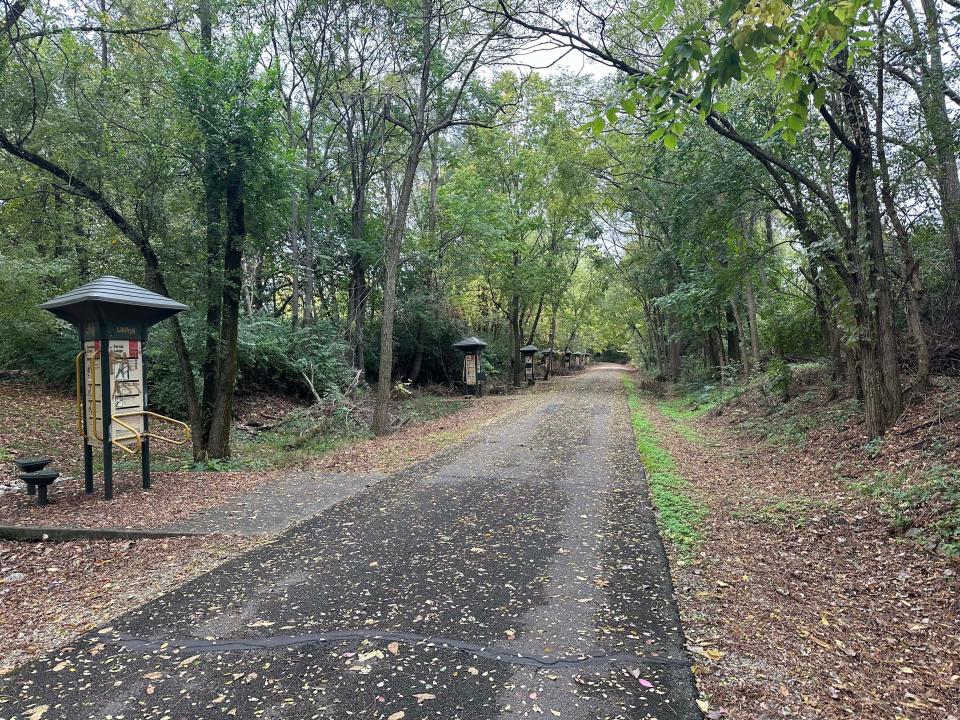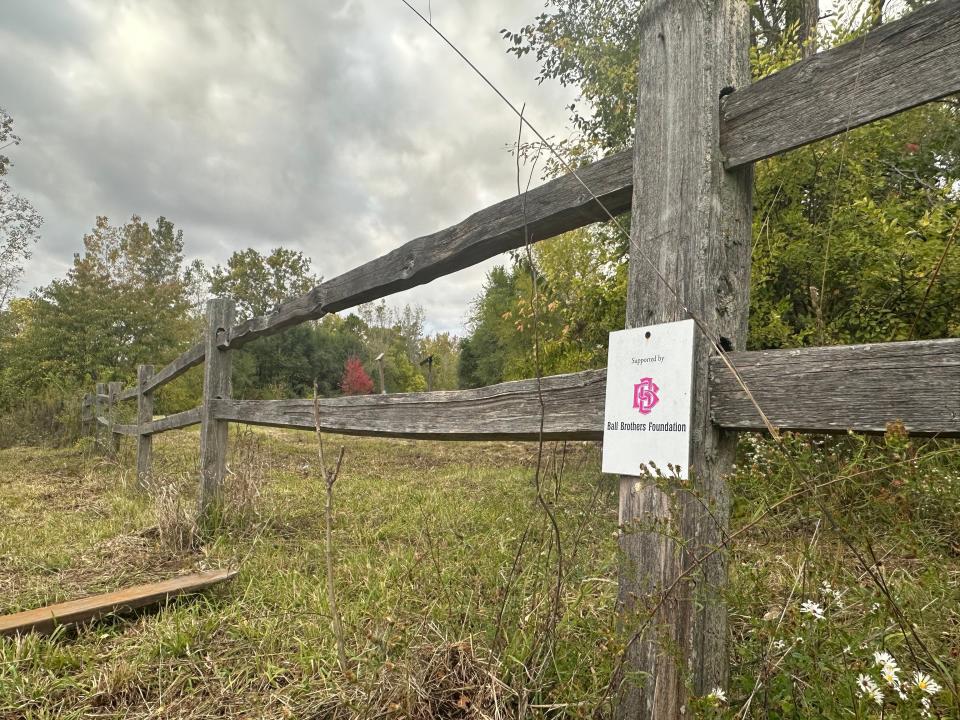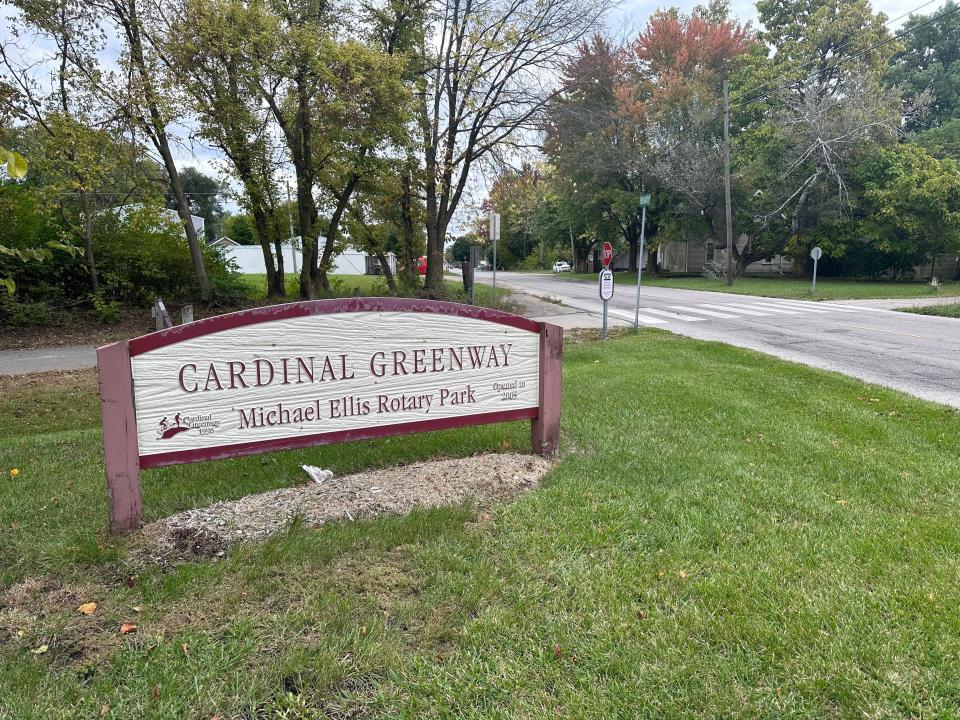Reduce. Reuse. Remediate? The clean-up of East Central Indiana abandoned industrial lots
Editor's Note: The following is part of a class project originally initiated in the classroom of Ball State University professor Adam Kuban in fall 2021. Kuban has continued the project, including this fall semester, challenging his students to find sustainability efforts in the Muncie area. The students pitched their ideas to Deanna Watson, editor of The Star Press, Journal & Courier and Pal-Item.
MUNCIE, Ind. – As you walk or ride along the Cardinal Greenway in Muncie, the former rail track repurposed for the community, a sanctuary of luscious greenery and dense vegetation alongside rich acres of trees will come upon you at Michael Ellis Rotary Park. Adjacent to the path is a large greenspace that was once a rusted, decaying junkyard plagued with debris and hazardous chemicals — killing the ecosystem around it, but now it is a natural space repurposed for the community.

This greenspace was the former Car Doctor's junkyard, a relic from the glory days when the automobile business ruled East Central Indiana. After being abandoned, the lot was classified as a brownfield by the United States Environmental Protection Agency (EPA). The EPA defines a brownfield as a property where hazardous pollutants or contaminants may complicate the expansion, redevelopment or reuse of the land.
Across this region of Indiana, industrial cities like Muncie, Anderson and Kokomo have been redeveloping these sites for the community. Some cities have developed these brownfields such as the Car Doctor’s junkyard into commercial districts for new companies or green spaces.
Over a five-year period starting in 2012, John Pichtel, professor of natural resources and environmental management at Ball State University, led classes of students to clean up and repurpose the Car Doctor’s brownfield sites into a green space. The student's findings were then published in the Proceedings of the Indiana Academy of Science.
When Dr. Pichtel and his students arrived at the scrapyard, Pichtel said the land had been eroded and essentially killed by over 100 cars along with automobile parts and chemicals scattered across the barren wasteland.
“Everything from front grills, hundreds and hundreds of tires, chunks of metal and glass from cars. Some people had even been dumping on the location. We even found part of a meth lab way out in the distance of the property. It was quite ugly,” said Pichtel.

These locations are remnants of Indiana’s Gas Boom in the mid-to-late 1800s, where factories and manufacturers flooded East Central Indiana cities for its abundance of natural gas. Many factories stayed in Muncie and surrounding areas such as Kokomo until the early 2000s, when most of these plants moved manufacturing overseas, often leaving the property in hazardous conditions. These factories and manufacturing plants often used hazardous chemicals and contaminants that have made it difficult to repurpose these sites.
“ Kokomo is a long-time industrial town, and the automotive industry has been here since the beginning, and there are other manufacturers of metal alloy and stuff like that. So it's hard not to go someplace that's close to a factory or manufacturing plant that doesn't have at least some level of contamination,” said Kokomo’s Development Specialist Steve Geiselman.
Kokomo, like many other communities in East Central Indiana, has a rich industrial history. As pointed out by Geiselman, factories and manufacturing plants can and have left behind some levels of contaminants, which can cause serious health problems.
The EPA lists heavy metals — arsenic, lead and mercury — along with polychlorinated biphenyls (PCBs) as common contaminants found on brownfield sites. High levels of contaminants such as heavy metals and PCBs have been present in the blood work of cancer patients in a Biometal study published in 2018.
If a brownfield is not properly remediated, these contaminants can have damaging health effects on neighboring communities. Delaware County Environmental and Development Planner Lorey Stinton said contaminants capped underground can pose issues when redeveloping or remediating a brownfield site.
“They have areas that are capped and cannot be disturbed. So when they talk about developing there (at a brownfield), you have a major concern because you can't dig into the ground; you can only build up,” said Stinton.
According to the EPA, capping is the process of covering up contaminated soil with other materials such as soil, clay, concrete and more. This does not clean the soil or remove any of the contaminates but instead isolates the contaminates and makes sure they do not spread anymore.

Pichtel said this possible disruption of capped soil along with other hazards and restrictions can have major effects on redevelopment or development near a brownfield. He said developers don’t want to build near these sites because of the possible spread of these contaminates that can come with building next to it.
This lack of development can affect more parts of the community than just the environment where they reside.
“It most importantly drives down property values. If you have one large brownfield in a large area and there's another land nearby that could be developed, some developers will say they don’t want to set up there because you have this large, unsightly (and) possibly dangerous location. Less companies mean less tax (dollars) coming into the city,” said Pichtel.
Fewer companies also mean fewer jobs for the community.
Anderson's Downtown Developer Levi Rinker said this is something the city of Anderson felt after General Motors (GM) Powerplant left the city, leaving approximately 20 General Motor plants abandoned. General Motors used to employ over 25,000 people who lived in Anderson, which would have been about 1 in every 3 people in the town who worked for them. After GM left Anderson, many locals were left without a job.
Rinker said these sites have now been either rebuilt or reused and have ultimately provided nearly 300 jobs for the community. This land has been redeveloped into businesses such as the Hello Nature headquarters, a community health pavilion, along with creating a Purdue Polytechnic campus with an expected 400 student enrollment.
All through this region of the state, abandoned lots like the Car Doctors junkyard in Muncie or the General Motors plants in Anderson have been left in potentially hazardous conditions, destroying the ecosystem and causing possible health concerns to nearby citizens. These locations that used to house the manufacturing of famous products and automobile parts like General Motors transmission are now being redeveloped into greenspaces, commercial districts, solar farms and more.
Even though some of these sites have been cleaned up, there are still more. Throughout Indiana, there are still brownfields. This past summer, the EPA granted eight communities in Indiana a total of $5 million for brownfield redevelopment and cleanup.
This article originally appeared on Lafayette Journal & Courier: East Central Indiana clean up abandoned industrial lots

